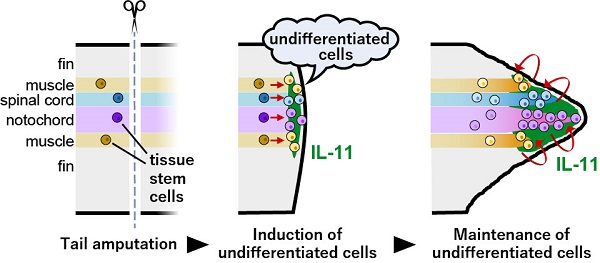Gene shown to induce undifferentiated cells during tadpole tail regeneration Earliest stage of regeneration reproduced in lab


interleukin-11 induces and maintains undifferentiated cells during tadpole tail regeneration.
The expression of the interleukin-11 gene, which induces the undifferentiated cells of several tissues, begins after the tadpole's tail is amputated. These undifferentiated cells form a massive population of proliferating cells called blastema. Part of these blastema cells differentiate to form the different tissues, while interleukin-11 guides the cells at the tip of the blastema to proliferate while retaining their undifferentiated state. The coordination of these two processes allows the regeneration to progress and a new functional tail to form.
© 2017 Hiroshi Tsujioka.
A group of researchers at the University of Tokyo found that a particular gene, interleukin-11, functions as a key factor in inducing and maintaining undifferentiated cells when tadpoles regenerate their tail.
Some animal species have the remarkable ability to reconstruct lost appendages. The African clawed frog (Xenopus laevis) is one such animal, with the tadpole possessing regenerative capabilities. When the tadpole loses its tail due to injury or other cause, it creates a new population of undifferentiated cells, called blastema, around the tail's stump, which proliferate and subsequently differentiate to form a new tail comprising a functional spinal cord, muscles, and other tissues. The molecular mechanisms that underlie this process of undifferentiated-cell generation and proliferation, and subsequent regeneration of the tail, however, remained a mystery.
The research group led by then-graduate student Hiroshi Tsujioka (currently specially appointed associate professor at the Immunology Frontier Research Center at Osaka University), Assistant Professor Taro Fukazawa, and Professor Takeo Kubo at the Graduate school of Science, the University of Tokyo, found that the interleukin-11 gene—which expresses itself selectively in the blastema cells that appear following the amputation of the tail—functions to induce and maintain several undifferentiated-cell lines, which form tissues needed for tadpole-tail regeneration. Moreover, when the group forced the expression of interleukin-11 in intact tadpole tails, it induced the expression of marker genes for immature progenitor cells that differentiate into nerve, notochord (larval structure located ventral to spinal cord), and muscle tissues. These findings suggest that the research group succeeded in reproducing the earliest stage of organ regeneration by inducing cell differentiation in the lab. These results also demonstrate for the first time that only a single factor, interleukin-11, is responsible for inducing and maintaining undifferentiated progenitor cells of several tissues.
This study should help us better understand the entire molecular and cellular process of the ability, limited to a few select species, to regenerate organs.
"I wanted to reveal molecular mechanisms common to various kinds of regenerative phenomena when I started my research." says Tsujioka. He continues, "It is important to examine whether interleukin-11 also induces and maintains undifferentiated cells in other regenerative phenomena, in future studies."
Assistant Professor Takekazu Kunieda of the Graduate School of Science, and Assistant Professor Yuki Katou, and Professor Katsuhiko Shirahige of the Institute of Molecular and Cellular Biosciences at the University of Tokyo also contributed to this study.
Paper
, "interleukin-11 induces and maintains progenitors of different cell lineages during Xenopus tadpole tail regeneration", Nature Communications Online Edition: 2017/09/08 (Japan time), doi: 10.1038/s41467-017-00594-5.
Article link (Publication)
Links
Department of Biological Sciences, Graduate School of Science
Laboratory of Physiological Chemistry, Department of Biological Sciences, Graduate School of Science






